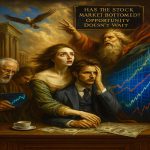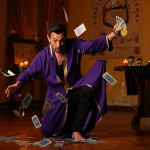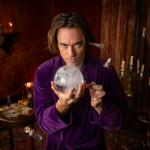
The Paradox of Perpetual Motion
May 30, 2025
In a dimly lit workshop tucked away in Geneva’s old quarter, a master craftsman hunches over a timepiece that has defeated him for months. The gears are perfect, the springs calibrated to microscopic tolerances, the escapement a marvel of engineering precision. Yet the clock refuses to keep time. It gains seventeen minutes each day, as predictable in its failure as it is exquisite in its construction.
This is the broken clock watchmaker’s eternal torment: the chasm between precision and prediction. He can craft components to tolerances measured in micrometres, can polish surfaces to mirror perfection, and can tension springs with the delicacy of a surgeon’s touch. But he cannot predict whether his creation will faithfully mark the passage of time or become an elaborate sculpture of mechanical futility.
The broken clock presents a peculiar paradox. Though it fails in its primary function, it achieves perfect accuracy twice daily—a feat that even the finest Swiss chronometer cannot guarantee with such mathematical certainty. At precisely 3:17 AM and 3:17 PM, this failed timepiece displays the correct time with unwavering reliability. In those moments, its precision transcends its dysfunction.
The watchmaker understands this irony intimately. His decades of experience have taught him that the relationship between craftsmanship and outcome follows no linear path. The most meticulously assembled movement might drift like a drunken sailor, whilst a hastily repaired mechanism could tick with remarkable fidelity for years. Prediction remains elusive, even when precision reaches its zenith.
The Illusion of Mechanical Control
This tension between craft and outcome extends far beyond the workshop bench. Consider the portfolio manager, hunched over Bloomberg terminals in Manhattan’s financial district, wielding analytical tools of breathtaking sophistication. Like the watchmaker, he commands precision instruments: algorithmic models calibrated to capture market volatility, risk metrics refined through decades of quantitative research, diversification strategies engineered with mathematical elegance.
Yet the market, like the temperamental timepiece, refuses to conform to even the most precise predictions. The S&P 500 can surge 3% on a Tuesday afternoon for reasons that defy the most sophisticated models. Tesla’s stock might plummet 8% on a single tweet, whilst Apple’s shares can remain frustratingly stagnant despite record-breaking earnings. The portfolio manager discovers what the watchmaker knows instinctively: precision in process does not guarantee predictability in outcome.
Warren Buffett, perhaps the investment world’s equivalent of a master craftsman, built Berkshire Hathaway’s extraordinary returns not through prediction, but through a disciplined process. His value investing methodology represents precision engineering applied to stock selection—meticulous financial analysis, patient capital allocation, and unwavering adherence to intrinsic value calculations. Yet Buffett readily admits he cannot predict when the market will recognise a stock’s true worth, just as the watchmaker cannot predict when his perfectly crafted movement will finally keep accurate time.
Timing the Untimeable
The broken clock’s twice-daily accuracy illuminates a profound truth about financial markets: timing often matters more than technique. A mediocre investment strategy executed at market bottoms can outperform sophisticated approaches deployed at peaks. The dot-com crash of 2000-2002 wiped out carefully constructed tech portfolios whilst rewarding those who happened to shift towards value stocks, not necessarily through superior analysis, but through fortuitous timing.
Consider the investor who purchased Amazon shares in early 2000 at $85 per share, believing in the company’s long-term potential. By late 2001, those shares had plummeted to $6—a 93% decline that would test any investor’s conviction. Yet holding through that darkness, like trusting a temporarily broken clock to eventually display correct time, ultimately proved transformational. Amazon’s stock would rise by over 28,000% from its 2001 lows to its 2021 peaks.
The watchmaker understands this temporal dimension intimately. A clock’s accuracy depends not merely on its internal mechanisms, but on its synchronisation with external time standards. Markets operate similarly—individual securities may possess intrinsic value, but their prices must eventually synchronise with broader economic reality. The question becomes not whether this synchronisation will occur, but when.
The Craftsman’s Patience
True mastery in both watchmaking and investing requires a unique form of patience—not passive waiting, but active preparation combined with the acceptance of uncertainty. The master craftsman continues refining his techniques, studying new complications, perfecting his tools, knowing that breakthrough moments cannot be forced or predicted. He remains perpetually ready for those instances when skill, timing, and circumstance align.
Peter Lynch exemplified this approach during his legendary tenure as manager of Fidelity’s Magellan Fund from 1977 to 1990. Lynch didn’t attempt to time markets or predict economic cycles. Instead, he focused relentlessly on identifying undervalued companies, visiting retail stores, talking to customers, and building deep knowledge across industries. His 29% annual returns resulted not from prediction, but from prepared positioning when opportunities emerged.
This patience extends beyond individual stock selection to portfolio construction itself. Modern portfolio theory provides the precision tools—efficient frontier calculations, correlation matrices, optimisation algorithms—but the market’s response to these carefully constructed portfolios remains stubbornly unpredictable. The 2008 financial crisis shattered many quantitatively optimised portfolios as correlations spiked towards one, destroying the diversification benefits that mathematical models had promised.
Embracing Beautiful Imperfection
The Japanese concept of wabi-sabi finds profound expression in both horology and finance—the beauty of imperfection, impermanence, and incompleteness. The broken clock watchmaker eventually learns to appreciate the aesthetic elegance of his failed timepiece, understanding that perfection in one dimension (visual beauty, mechanical precision) need not require perfection in all dimensions (temporal accuracy).
Successful investors similarly embrace imperfection. Ray Dalio‘s Bridgewater Associates built one of the world’s largest hedge funds not by avoiding losses, but by creating systems that fail gracefully. Dalio’s “Principles” emphasise learning from mistakes, questioning assumptions, and building portfolios that can withstand unpredictable market shocks. Like the watchmaker who accepts that some clocks will never keep perfect time, Dalio accepts that some investments will inevitably fail—the key lies in ensuring that failures remain contained whilst successes compound.
This acceptance of beautiful imperfection paradoxically leads to superior long-term outcomes. Index fund investing represents the ultimate expression of this philosophy—accepting that individual stock selection cannot be consistently predicted, whilst trusting that market precision will eventually reward patient capital allocation. The Vanguard S&P 500 Index Fund has delivered approximately 10% annual returns over decades, not through prediction, but through participation in the market’s collective precision over time.
The Final Calibration
In the end, the broken clock watchmaker discovers something profound: his true skill lies not in predicting outcomes, but in crafting processes robust enough to capture success when it emerges. The broken clock that displays correct time twice daily becomes a metaphor for investment strategies that may appear dormant for extended periods before delivering extraordinary returns.
Benjamin Graham’s value investing principles, largely ignored during the 1990s tech bubble, seemed like a broken clock—technically sound but temporarily irrelevant. Yet when market cycles turned, those principles proved prescient twice a day, every day, delivering superior returns to those patient enough to maintain precision whilst accepting unpredictability.
The watchmaker’s final lesson transcends both timepieces and portfolios: true mastery lies in building systems precise enough to recognise opportunity, patient enough to await optimal timing, and humble enough to accept that prediction remains forever beyond human reach. In this acceptance, both broken clocks and volatile markets reveal their hidden wisdom—sometimes being perfectly right twice a day proves more valuable than being approximately wrong all the time.










